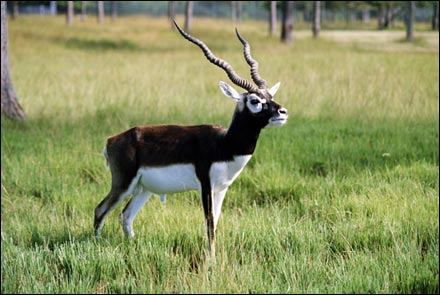
Local name: Kala Hiran (Urdu)
Description and Biology:
Size:Body Length: 100-150 cm / 3.3-5 ft.
Shoulder Height: 60-85 cm / 2-2.8 ft.
Tail Length: 10-17 cm / 4-6.8 in.
Weight: 25-35 kg / 55-77 lb.
Description: One of the few antelope which exhibits pronounced sexual dimorphism, the genders in the blackbuck are readily distinguishable. Both sexes have white underparts, including the insides of the legs and lower chest, as well as a white ring surrounding the eye and a white chin. Females and young are yellowish-fawn on their back and head, and are generally hornless. Males gradually darken from tan to deep brown or black with age, beginning after 2 years. The build is slender, and the tail short. The horns, found only in males and appearing before their pronounced colour change, are twisted in a tight spiral with up to five turns. Ridged laterally, they may grow 35-73 cm / 14-29 inches.
Reproduction: Gestation Period: 5-6 months. Young per Birth: 1 Although breeding can occur throughout the year, there are peak periods in March-May and August-October. Weaning: 5-6 months. Sexual Maturity: 1.5-2 years. Life span: 10-12 years, rarely up to 18.
Social Behavior: During the cooler seasons, blackbuck are diurnal, and active intermittently throughout the hours of daylight. As the temperature rises, however, they are more often seen grazing in the open in the early morning and late afternoon, sheltering from the sun for the rest of the day. When a potential threat is spotted, the alert females are usually first to sound the alarm, with one individual leaping into the air. This motion is followed by the entire herd, although after a few large bounds the herd reduces its pace to a normal gallop. One of the fastest land mammals, blackbuck have been clocked going in excess of 80 kmph / 48 mph.. During the breeding season males become territorial, defending an area usually ranging in size from 1 to 17 hectares from rival males, and attempting to keep the largest group of females within it for the longest period of time. This territoriality can last anywhere from two weeks to eight months. Mixed herds with 5-50 animals, generally with three or fewer males. Bachelor herds are known. Dominance among males within a herd is achieved primarily with posturing and threatening gestures: fights with the sharp horns are rare.
Diet: Leaves, buds, grasses, field fruits. (all above information from “The Ulimate Ungulate Page” by Brent Huffman).
Habitat and Distribution:
Blackbucks are native to India and Pakistan, where they were widespread in plains and open woodlands; western deserts, and northern mountains limited their distribution. Today, extensive hunting and habitat destruction have restricted blackbuck to only small, isolated populations in their former native habitat.In Pakistan the blackbuck lives in semi-desert areas, such as Cholistan and Thar. Today the blackbuck is an ocassional staggler along the eastern desert border areas of the country. There is no permant resident population today in Pakistan. During the late 1970’s and early 80’s small populations of blackbuck were brought from Texas, U.S.A to start a reintroduction program in Pakistan. These projects have had some success and now there are small captive populations of blackbuck in 3-4 locations, particularly in Kirthar and lal Sohanra National Parks. The breeding success achieve at Lal Sohanra is 413 animals (Dr. A.Aleem,1998) where as from Khar time to time number of Black Bucks provided to the eminent conservationists for further propagation in their private reserve. At present about 500 animals are surviving in Mir of Khairpurs Mehrano reserve, 110 at Khangur, Ghotki and 70 at New Jatoi, Nawab Shah. However at Khar Center only 35 animals (R.A.Rajput 1999) remain. Except these, some are kept in different zoo’s, wildlife centres and in possession of individuals. At present all together about 1500 Black Bucks are reared in captivity and they are surviving in Punjab and Sindh regions of Pakistan. These will be released in the wild in the near future.
